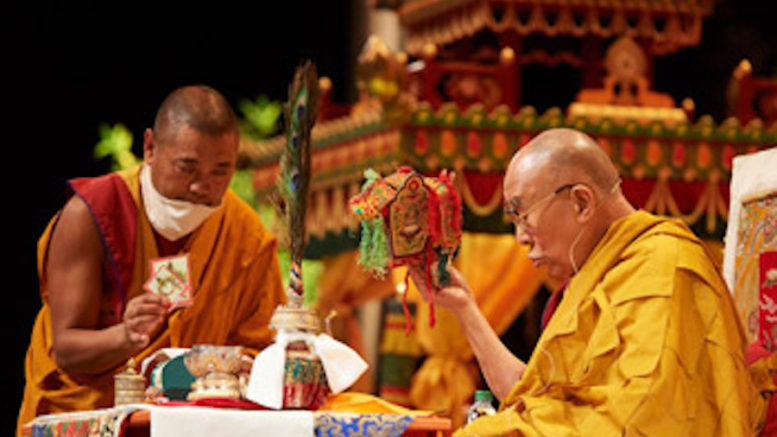Strasbourg, France, 18 September 2016 – It was dark and raining when His Holiness the Dalai Lama left his hotel for the Zénith Strasbourg this morning. Dawn broke on the way and he was warmly received when he arrived. Sitting before the mandala pavilion he engaged immediately with preparations for the empowerment he was to give. An hour or so later, he addressed the audience.
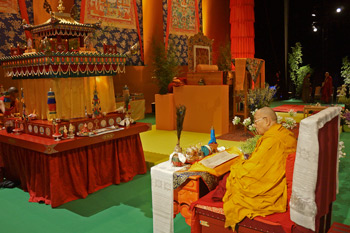
“As I was saying yesterday, Buddhist teachings can be seen as fitting into a general structure or as tailored to a specific target. Today’s teachings belong to the second category. This empowerment concerns Avalokiteshvara, the Great Compassionate One. The Nyingma tradition speaks of distant, close and profound visionary teachings; this belongs to the latter. It belongs to the great 5th Dalai Lama’s ‘Secret Visions’.
“Regarding ecumenical and non-sectarian practice, I didn’t pursue it to begin with because of my connection with Dolgyal (Shugden). The 5th Dalai Lama described Dolgyal as a ‘perfidious spirit’ who harms the doctrine and sentient beings due to having made flawed prayers. Once I gave up having anything to do with Dolgyal I was able to receive explanations of Nyingma practices, including the ‘Secret Visions’, from Dilgo Khyentse Rinpoche, which were very helpful. I found guidance on the nature of the mind helpful in understanding the completion stage of Guhyasamaja.
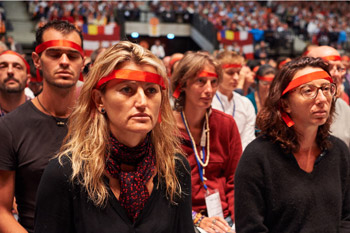
“I received the whole transmission of the ‘Secret Visions’ when I was a boy from Tagdrag Rinpoche. I didn’t pay close attention at the time, but I remember having certain dreams. In exile I was able to do a retreat for the whole cycle of teachings.
“I hear that some people report that I have said no one should do the practice of Dolgyal. That is not what I say. There are problems with the practice, which I know from my own experience, and that’s why I recommend people not to do it. But if someone wants to do it, they can. There are monks today in monasteries adjacent to Ganden and Sera who specifically follow the practice.
“What I do say is that Dolgyal broke his bond with the 5th Dalai Lama and has been controversial ever since. I’ve encouraged people not to do the practice, but I haven’t said that no one can do it.”
His Holiness explained the Nine Yanas or Vehicles presented in the Nyingma tradition. These include the three outer yanas related to the practices of Hearers, Solitary Realizers and Bodhisattvas; the three outer tantras, Kriya, Charya and Yoga, as well as three inner tantras, Mahayoga, Anuyoga and Atiyoga. Understanding of emptiness is related to all nine yanas, but Kunkhyen Jamyang Sheypa said that while both sutras and tantras teach emptiness, the difference is in the superior subjective mind of tantra. His Holiness said the present empowerment belongs to the category of Mahayoga and within that to the Padma lineage.
Observing that tantric practice requires the use of a vajra and bell, His Holiness stated that the vajra represents method, while the bell represents wisdom. In higher tantras the vajra symbolises the subtle mind of clear light, the mind of bliss, and the bell symbolises the wisdom realising emptiness. What is important is not what the vajra and bell are made of, but what they represent. Method and wisdom refer to the causes of enlightenment. The damaru hand drum is used to symbolise igniting the inner heat.
His Holiness embarked on giving the empowerment, which also entailed giving the vows of a lay-practitioner, generating the awakening and giving the bodhisattva vows. At the end, he urged everyone who had taken the empowerment to engage in practice.
In his public talk after lunch, His Holiness reiterated that whoever he meets he thinks of as equally another human being, physically, mentally and emotionally like him. He said the purpose of life is to be happy and hope is the basis of our survival. He recalled his first visit to Europe in 1973 and expecting to find happier people in developed countries. Instead, many were stressed and anxious. In the USA, he met immensely wealthy people who in themselves were unhappy. He concluded that material development does not by itself bring peace.
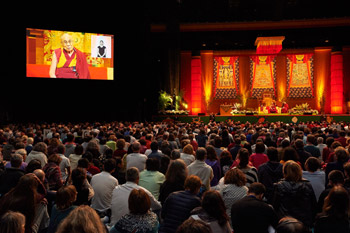
“Despite our basic human nature being compassionate,” he said, “and all 7 billion human beings having the potential to become more compassionate, the education system is oriented towards material goals. It doesn’t deal with inner values, nor does it reveal how to achieve inner peace. Although religion traditionally addressed these things, today one billion human beings take no interest in it, while many of those who call themselves religious don’t really take it seriously. Educationalists, scientists and other friends I’ve talked to agree we need to take a different approach to promoting universal values based on common sense, common experience and scientific findings.”
His Holiness mentioned his commitments to promoting human happiness and religious harmony. He added that as a Tibetan he retired from his political role in 2011, but remains avidly concerned to preserve Tibetan culture and language and working to protect Tibet’s fragile natural environment. He suggested that whoever can go to Tibet to see for themselves what is happening there and report what they find to Chinese they meet.
A member of the audience sought his advice on restoring confidence to a society shocked by a series of terrorist attacks. He suggested not dwelling so much on particular incidents, but trying to step back and seeing them in a wider context. When another question was put about the role of humility, he was clear that it is a quality that should be founded not on timidity but on strength and confidence.
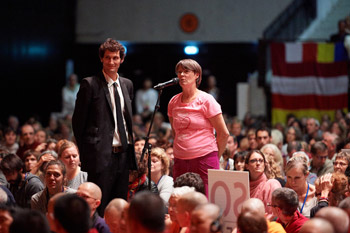
Asked his position on the treatment of animals His Holiness replied that of course Buddhists pray for the welfare of all sentient beings, because they all want and are entitled to a happy life. He mentioned that when Tibetan farming settlements were established in South India they avoided methods that only led to slaughter. He reported that at the age of 15 in Tibet he stopped the serving of meat at state banquets. In exile, the main kitchens of the great monasteries now only prepare vegetarian food.
“However,” he confessed, “although I encourage others to follow a vegetarian path, I myself am not a vegetarian. There is a contradiction. The reason is that I was a strict vegetarian for 20 months in the 60s until I fell ill with hepatitis. As a result my doctors advised me to resume the mixed diet my body was used to.”
With regard to creating a more peaceful world, His Holiness declared that education is the key factor.
“Peace,” he said, “does not depend on having money or power; even less on the weapons we can deploy. Peace essentially depends on our cultivating warm-heartedness.”
As the audience expressed support and approval in sustained applause, he appealed to them to ask themselves if what they had heard seemed reasonable. If it did, he suggested they put it into effect and share it with others. If it didn’t, he said they were welcome to forget it.

